Exploring the Impact of Forager Slow Feeders in Agriculture
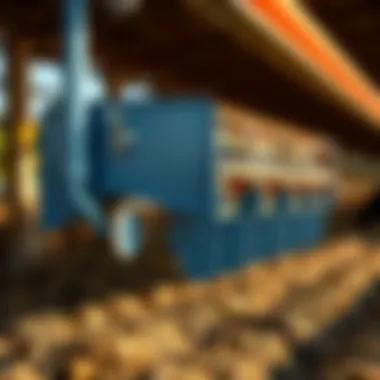
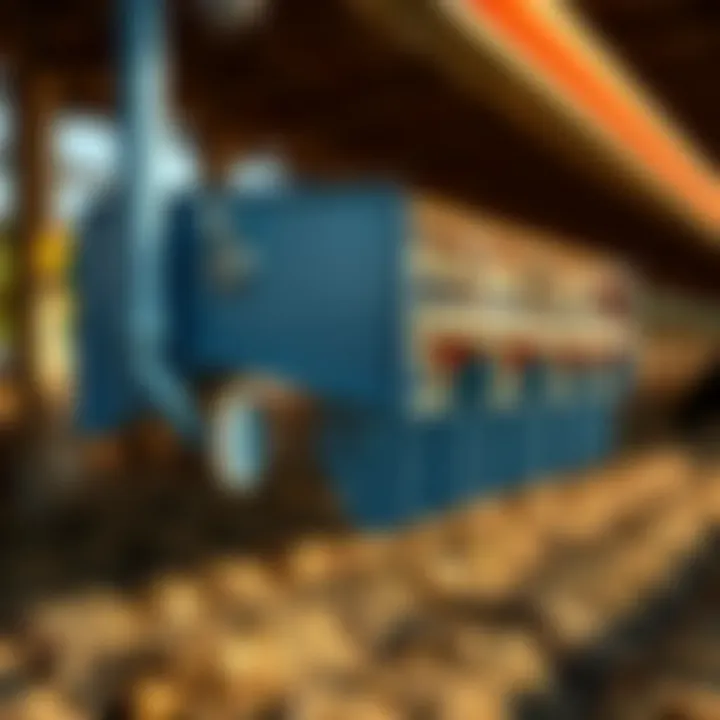
Intro
The agricultural, landscape is rapidly changing, and one of the concepts gaining attention is the role of forager slow feeders. These systems are not just a fad; they represent a thoughtful approach to animal husbandry and resource management. The modern farmer faces pressures from efficiency demands and sustainability concerns, often feeling like they're juggling flaming torches. The introduction of slow feeders offers a beacon of hope, aligning with principles of animal welfare while harnessing nature’s bounty effectively. The conversation around these feeding systems is more relevant than ever, as they hold the key to balancing productivity and ecological health.
In the following sections, we will dive deeper into what forager slow feeders are, their evolution in agricultural practices, and how they can be effectively utilized for better farming outcomes. Through an exploration of techniques, case studies, and real-world insights, this piece aims to arm farmers and agricultural enthusiasts with the knowledge to make informed decisions on incorporating sustainable practices into their daily operations.
Preamble to Forager Slow Feeders
The integration of forager slow feeders within agricultural practices marks a significant shift in how livestock is managed and fed. These systems not only enhance animal welfare but also align with sustainable farming principles. As the farming landscape evolves, the need for innovative feeding methods becomes paramount. Employing slow feeders can lead to better resource utilization, optimal forage management, and overall improved health for livestock, which ultimately benefits the farmer's bottom line.
For greater clarity, forager slow feeders can be simply defined as systems designed to provide fodder in a way that encourages animals to consume their food more slowly and deliberately. This model is modeled after natural foraging behaviors. Results have shown that these systems can drastically improve digestive health, reduce anxiety among livestock, and even minimize waste. The idea here is not just to feed animals; it's about transforming how they interact with their food and environment.
Definition of Forager Slow Feeders
Forager slow feeders are specialized devices or systems implemented within agricultural settings to promote orderly feed consumption among various livestock species. Unlike conventional feeding methods that may allow animals to gobble up their feed in a matter of minutes, these systems are structured to extend feeding time. They encourage livestock, such as cows, goats, and horses, to graze and forage prolifically as they would in their natural habitats.
This slow feeding practice can be facilitated through various designs—like hay nets, feeding racks, or specially designed troughs—that create barriers to rapid consumption. The primary goal is to simulate the natural foraging experience that animals tend to enjoy. By doing so, animals take their time, leading to more effective digestion and healthier body weight management, thereby translating into both short-term and long-term benefits for the animal and farmer alike.
Historical Context of Foraging Practices
Historically, the practice of foraging has been rooted deep in farming traditions. Before the advent of industrial farming techniques, animals thrived on pasturelands, freely grazing and foraging as nature intended. This natural behavior maximized their nutrient intake while reducing feed costs for farmers. Over time, however, the introduction of confinement systems and concentrated feed sources disrupted these natural habits.
Starting from ancient agricultural societies, where livestock roamed freely, farming evolved as civilizations grew. With advancement, farming started to rely more on efficiency than animal well-being, leading to the emergence of rapid feeding methods that often caused health issues like obesity or digestive disorders in livestock. Today, as awareness surrounding animal welfare has grown, so has the need to return to systems that respect natural behaviors. The resurgence of forager slow feeders speaks volumes about this trend—the transition marks a commitment not just to productive agriculture, but to a more ethical approach that challenges the norms established by decades of industrial farming.
To summarize, forager slow feeders provide a window into a future that values both sustainable agricultural practices and animal welfare, aligning with the growing movement towards holistic farming strategies.
Principles Behind Slow Feeding
Within the realm of agriculture, the principles governing slow feeding are essential to understanding how this method can reshape practices around livestock management. Slow feeding is not just about feeding techniques; it dives into the natural behaviors and requirements of various species, positively impacting animal welfare and resource efficiency. In times where sustainable practices are gaining momentum, recognizing these principles offers vital insights to farmers and enthusiasts alike.
Mechanisms of Slow Feeding
Slow feeding fundamentally hinges on mimicking natural feeding behaviors. Animals, when left to their own devices, typically nibble and graze throughout the day rather than gorging themselves in one sitting. Integrating slow feeders into their routine not only prolongs feeding times but also encourages horses, cattle, goats, and even small ruminants to engage more naturally with their environment.
The mechanisms are varied but often include:
- Physical barriers: These are designed to limit the amount of forage accessible at one time, forcing animals to work for their food. This design promotes foraging behavior and prevents rapid eating.
- Adjustable openings: Some slow feeders have openings that can be modified, allowing for tailored feeding experiences based on animal size or type.
- Bedding material use: Incorporating different bedding types or surfaces within the feeder can also encourage animals to forage rather than consume food outright, establishing a more instinctual feeding rhythm.
Implementing such mechanisms not only improves nutritional intake but fosters mental stimulation, enhancing overall well-being.
Physiological Benefits for Animals
The physiological aspects of slow feeding are significant and manifold. When livestock consume food at a gradual pace, it can drastically affect their health and comfort levels. Several studies have drawn connections between slow feeding and various health benefits.
- Reduced digestive issues: Quick consumption often leads to inadequate chewing, which can precipitate problems like colic or laminitis, particularly in horses. By slowing their feeding, these risks can be mitigated.
- Stable blood sugar levels: Animals that feed slowly tend to maintain a more stable glucose level. This balance helps avoid the drastic spikes and drops that can come from eating too quickly.
- Improved mental health: Animals staying engaged with their surroundings tend to exhibit behaviors correlated with lower levels of stress. This is especially true in social structures of herds where animals are encouraged to interact while feeding.
In essence, the principles behind slow feeding present a blend of behavioral science, veterinary benefit, and practical application that resonates with progressive farming methods.
Adopting slow feeding practices can yield long-term advantages, ultimately fostering healthier livestock and a more sustainable agricultural environment. The farmers’ role, therefore, extends beyond simply feeding but also embracing the complex dynamics of animal well-being.
Design and Construction of Forager Slow Feeders
The design and construction of forager slow feeders is fundamental to their effectiveness in agricultural practices. These systems are not merely functional items; they play a vital role in ensuring that animals are fed in a way that mirrors their natural foraging behavior. Sustainable design helps in optimizing resource use and enhancing animal welfare, addressing both efficiency and animal health.
Materials and Durability
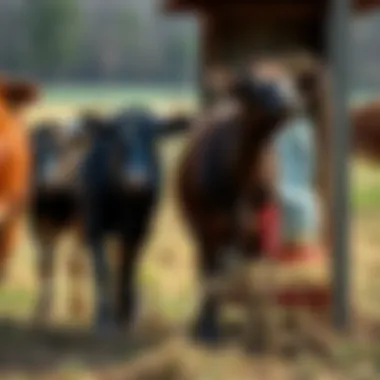
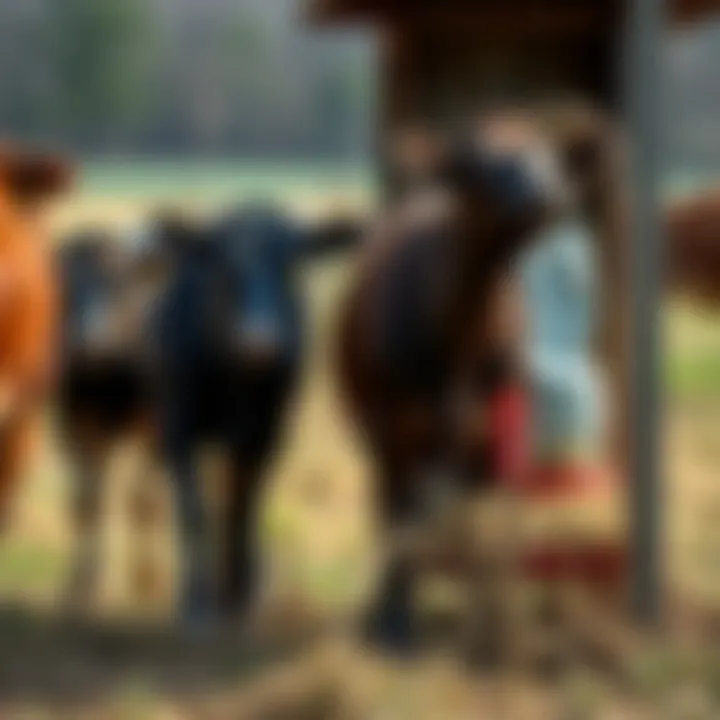
When it comes to materials, choosing sturdy yet safe options is key. Commonly used materials include wood, metal, and certain plastics that do not leach harmful substances. Wooden feeders, for example, offer a natural aesthetic and blend into various environments while being robust enough to withstand daily wear and tear.
Metal, on the other hand, provides enhanced durability, but it’s essential to use corrosion-resistant options to avoid rusting, especially in outdoor conditions. Also, the longevity of the feeder is paramount—investing in durable materials signifies long-term savings, as replacements will be less frequent. The ideal feeder must withstand both the elements and the animals themselves.
Different Designs Suited to Various Species
Cattle
Cattle are often raised in systems where space and forage availability determine feeding success. A well-designed forager feeder for cattle focuses on their bulk intake capacity. Many designs employ a large, open structure that allows multiple animals to eat simultaneously, fostering social interaction while minimizing stress. A pronounced feature of cattle feeders is their ability to mitigate feed waste, which is crucial for efficient resource management. While some feeders require regular maintenance, investing in quality construction leads to less hassle down the line.
Goats
For goats, forager slow feeders need to support their climbing and browsing instincts. Goats are naturally inclined to explore vertical routes, thus a feeder that utilizes height effectively, perhaps through suspended hay nets, is advantageous. These nets not only keep the feed off the ground, reducing contamination but also engage the goats mentally. However, it is essential that such designs are safe and will not allow the goats to become entangled. Careful design can result in high levels of satisfaction and playfulness among the herd.
Horses
Designing feeders for horses requires attention to their unique eating style. Horses have a natural inclination to graze for extended periods. Feeder systems that slow down their intake can reduce the risk of colic and other digestive issues. For instance, a design with small openings allows horses to selectively eat while being challenged to work slightly. This controlled feeding not only prolongs their mealtime but also encourages natural behaviors. It’s critical to ensure that any feeder used for horses is both safe and easy to clean—unmaintained feeders can lead to health problems.
Small Ruminants
The feeder designs for small ruminants such as sheep require a balance between accessibility and sustainability. These creatures often prefer to nibble at their feed throughout the day. Feeder constructions that allow for free-choice access help mimic their grazing habits. Compact feeders can be tailor-made for smaller spaces and flock sizes, providing just the right amount of nutrition while ensuring efficiency. Such designs can also include features for mixed feeding methods, such as hay and grain, appealing to the dietary diversity these animals may require.
Overall, the design and construction of forager slow feeders is a nuanced endeavor, requiring close attention to the animal's natural behaviors, preferences, and environmental needs. The benefits reaped from thoughtful design are manifold, creating a profound impact not just on the individual health of livestock, but also on their productivity and overall farm sustainability.
Ensuring that forager slow feeders are constructed with the right materials and designs tailored to the specific species fosters a healthier and more efficient agricultural realm, while also promoting sustainable practices. For more insights, consider exploring resources at Britannica and Wikipedia, which provide foundational knowledge on animal behaviors.
Ecological Impact of Slow Feeders
The role of slow feeders in agriculture extends beyond just animal care; it deeply intertwines with ecological health and sustainability. Implementing forager slow feeders contributes significantly to fostering a balanced ecosystem. This section explores how these feeding mechanisms not only enhance the well-being of livestock but also positively affect biodiversity and resource management.
Promoting Biodiversity Through Foraging
One of the most striking benefits of slow feeders is their ability to enhance biodiversity. When animals forage naturally, they play an integral role in their environment. For example, cattle grazing in pastures enables plants to grow fuller and healthier. This isn't just about them chewing grass—it promotes a richer variety of plant species. By allowing different flora to thrive, these feeders help in sustaining various forms of wildlife, thereby increasing the biodiversity in the area.
In various ecosystems, diversity is crucial. It protects against pests and diseases and maintains soil productivity. Using slow feeders can create patches of land that are more resilient, supporting complex webs of life. In a nutshell, the more diverse the ecosystem, the healthier it becomes.
"Biodiversity is not just a number; it's the foundation of ecosystem health and resilience."
Moreover, these feeders can encourage specific feeding behaviors that naturally prune and aerate the soil. They offer animals a chance to engage with their environment in a way that mimics natural foraging behaviors, which can be beneficial for the ecology of the grazing land.
Resource Management and Efficiency
Forager slow feeders are also pivotal in optimizing resource management within agricultural systems. By controlling how and when animals access feed, these systems reduce waste significantly. Traditional feeding methods often lead to over-consumption and spoilage of feed. With slow feeders, livestock are encouraged to take their time, making the most out of every bite.
This thoughtful approach to feeding translates into more efficient use of resources. Farmers can utilize their forage more effectively, which can reduce the need for supplementary feed. This not only saves costs but also minimizes the carbon footprint associated with feed production and transportation.
Some key points to consider in resource management are:
- Reduced feed waste – With slow feeders, there's less spoilage and waste.
- Enhanced soil health – As livestock graze, they cycle nutrients back into the soil, improving its fertility.
- Sustainable water use – Properly managed foraging can reduce water usage associated with feeding.
Integrating slow feeders into pasture systems creates a sustainable loop where animals, plants, and the broader environment work in harmony. Efficiency in resource use leads to lower costs and a reduced ecological footprint, making slow feeders a wise choice for anyone serious about sustainability in agriculture.
As farmers and agricultural enthusiasts embrace these methods, the momentum toward sustainable practices in farming continues to grow, showcasing a bright future for both agriculture and the ecosystems it inhabits.
Forager Slow Feeders in Practices
Forager slow feeders play a crucial role in modern agricultural practices. While their primary purpose is apparent—providing a steady and measured food supply—there's much more beneath the surface. Integrating these feeding systems can enhance the overall productivity of the farm, improve animal health, and lead to sustainable farming practices. Understanding how these systems function within the broader context of agriculture can help farmers make informed decisions and optimize their operations.
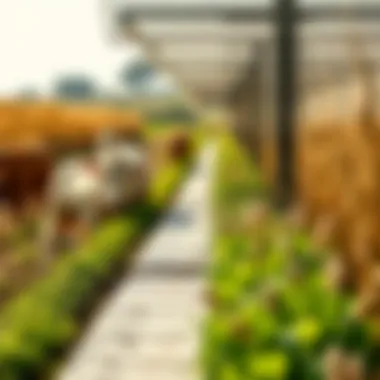

Integration Into Pasture Systems
The integration of forager slow feeders into pasture systems is not simply a trend; it is a thoughtful shift towards more sustainable agriculture. Slow feeders encourage animals to engage in natural foraging behaviors, which aligns with their instinctual patterns. Think about it—a cow in a pasture that can graze at its own pace will likely be more satisfied than one fed hastily and without choice.
Incorporating these feeders involves spatial arrangement and management. For instance, placing feeders near shaded areas can provide cows relief from hot weather, promoting better intake of forage. This strategy not only improves the well-being of the animals but also encourages balance in pasture utilization. A well-placed feeder can result in even grazing and resource management, reducing overall soil erosion and promoting biodiversity.
Moreover, by regulating the feeding process, slow feeders minimize waste. As a result, farmers can witness a significant drop in feed costs over time. This setup leads to fewer inputs while maintaining desired outputs. It's like hitting two birds with one stone—the financial aspect and ecological benefits work hand in glove. This integration ensures that both pasture health and animal welfare are prioritized.
Supplementing With Forager Slow Feeders
Supplementing with forager slow feeders extends the benefits of traditional feeding methods. When feed is provided in these specialized feeders, animals can consume at a pace that suits them. This gradual intake has been shown to aid digestion and can reduce the occurrence of gastrointestinal issues, a common concern in livestock management.
Here are a few key pointers on the benefits of supplementing:
- Improved Nutrient Absorption: Slow feeding allows for better mastication, breaking down food effectively. This improves nutrient absorption, leading to healthier animals.
- Reduced Stress Levels: Animals experience less competition for food, leading to calmer behavior during feeding times.
- Versatile Feeding Options: Farmers can introduce various foraging materials, such as hay, grains, or special mixes tailored to different livestock needs. The flexibility in feeding options means farmers can adapt to seasonal changes more easily.
In summary: Supplementing forager slow feeders not only enhances animal health but also optimizes feed efficiency, paving the way for prosperous and sustainable farming practices.
Challenges and Considerations
The integration of forager slow feeders into agricultural practices certainly holds promise, but, like anything else, it's not all sunshine and rainbows. Understanding the challenges and considerations associated with these systems is crucial for farmers and enthusiasts aiming to implement them effectively. It’s a delicate balance between animal welfare, resource management, and practical application. Striking the right chord here is important because the decisions made can impact overall efficiency and sustainability in farming systems.
Potential Drawbacks of Slow Feeding
Slow feeding systems might not be an all-encompassing solution. There are several potential drawbacks worth dissecting. First off, the initial investment can be a hefty pill to swallow. Quality materials and smart design can set back farmers significantly. For those on tighter budgets, this upfront cost might deter them from embracing this technique. It’s a classic case of weighing the short-term pain against long-term gain.
Additionally, while slow feeders are designed to promote healthy grazing patterns, it requires time for animals to adjust. Some livestock may take longer than anticipated to learn how to effectively use these systems. The learning curve can be steep, especially for younger animals or those that have been accustomed to more traditional feeding methods. Initially, you might notice some animals turning their noses up at the slow feeder entirely, leading to missed feeding opportunities.
Another thing to keep your eyes peeled for is the loss of nutritional quality in feed given some slow feeder designs can allow for spoilage. If not monitored closely, farmers might find themselves with animals consuming feed that’s not up to snuff, which can adversely affect health outcomes.
Overcoming Common Obstacles
Now, addressing these challenges is where innovation and critical thinking come into play. Let's tackle some common obstacles head-on. First, farmers can mitigate initial costs by sourcing materials wisely or even considering DIY slow feeder designs. Various online resources offer blueprints and suggestions for building feeders that don’t break the bank but still serve their purpose effectively. Check out websites like Instructables.com for do-it-yourself ideas.
Education is key. Providing proper training for both livestock and handlers can ease the transition to slow feeders. Gradual introduction can help; consider allowing animals some initial access to the traditional feeding while slowly blending in the slow feeding method.
To counter any potential spoilage issues, regular monitoring of the feed quality is essential. Implementing a routine check can help ensure that feed remains fresh and nutritious, keeping animals healthy and vibrant. Farmers might even consider investing in moisture-resistant systems or designs specifically engineered to reduce spoilage, which can ultimately save money in the long run.
Implementing these strategies can empower farmers to make the most of forager slow feeders while navigating the hurdles they might encounter.
"A smooth sea never made a skilled sailor."
With careful consideration of potential drawbacks and proactive strategies for overcoming obstacles, farmers can transform these challenges into stepping stones towards a more sustainable agricultural practice.
Case Studies and Real-World Examples
Understanding how forager slow feeders fit into agriculture isn't just academic; looking at real-world examples provides insights that theory alone cannot give. Successful implementations or cautionary tales from others' experiences can inform better practices, making it crucial to delve into these case studies. They illuminate the nuances of slow feeding systems, outlining both their potential and the challenges farmers might encounter.
Successful Implementations in Various Regions
Across the globe, several farms have adopted forager slow feeders with notable success. For instance, a dairy farm in Wisconsin integrated slow feeders to enhance the grazing schedule for their milking herd. They observed cows became less stressed and produced more consistent milk yields compared to previous years. Regular grazing and slow feeding allowed the cows to digest their feed better, leading to improved overall health.
In another example, a sheep farm in New Zealand tailored slow feeder design specifically for their flock. They utilized materials that were durable against the weather, ensuring that the feeders held up against rain and wind. With a combination of pasture rationing and slow feeding methods, this farm could maintain an optimal growth rate for their lambs while minimizing wastage remarkably.
Furthermore, feeding technology has found its way into even the most traditional practices. In parts of Spain, farmers have started using a combination of digital sensors and slow feeders. These sensors monitor how much each animal eats, helping to adjust feeding schedules based on day-to-day changes in the animals’ appetites. This level of precision is encouraging farmers to invest further in such systems, effectively marrying age-old methods with contemporary technology.


Lessons Learned From Failures
However, not all endeavors have been as smooth sailing. There are valuable lessons to draw from instances where slow feeders did not perform as expected. For example, a cattle ranch in Texas experimented with a new design that ultimately did not accommodate the cattle's feeding behavior. The initial concept appeared promising; however, the structure did not allow for enough access during peak feeding times. The ranch saw a slight drop in milk productivity and an increase in feed waste, prompting a reevaluation of the feeder design.
Another eye-opener came from a goat farm in Virginia that neglected to choose the right materials for their slow feeders. They initially constructed feeders from untreated wood, which deteriorated rapidly under the elements. The goats tended to chew on the wood, introducing health risks. This oversight forced the farm to switch to metal feeders, understanding that durability is as crucial as the feeding mechanism.
These experiences underline the importance of thorough planning and execution when implementing forager slow feeders. Adjustments based on animal behavior, environmental conditions, and material choices can make or break the effectiveness of such systems.
"Success is not final; failure is not fatal: it is the courage to continue that counts." - Winston Churchill
In summary, case studies provide invaluable insights that can help farmers assess the suitability and effectiveness of forager slow feeders in their practices. By learning from both implementations and missteps, agricultural professionals can fine-tune their strategies to not only enhance productivity but also ensure animal welfare.
Future Directions in Slow Feeding Technologies
Progress in agricultural practices, especially in the realm of slow feeding technologies, has the potential to reform traditional farming methods. Recognizing the importance of this evolution helps address the needs of animals and cultivates sustainable farming practices. As resource management becomes increasingly crucial amid climate concerns, the integration of innovative feeding solutions promises streamlined operations and better animal welfare.
Innovations in Feeding Systems
The heart of advancing slow feeding technology lies in developing innovative feeding systems that cater to various animal species. These systems work towards preventing overconsumption while ensuring that animals receive adequate nutrition throughout their day. Not only does this keep animals healthier, but it also optimizes feed efficiency, reducing waste.
For instance, some of these systems employ a design that encourages natural foraging behaviors. By making food available in a manner that mimics how animals graze in the wild, these systems promote mental stimulation and reduce stress levels. Utilizing materials that endure wear is vital here; options like high-density polyethylene or galvanized wire ensure longevity, allowing farmers to focus on care without worrying about system replacements.
Integrating Technology into Foraging
Smart Feeding Technology
Smart feeding technology provides a revolutionary approach to managing the diet of livestock. By employing sensor technology, these systems can track individual eating patterns and adjust feed delivery accordingly. The primary characteristic of smart feeders is their ability to learn, enabling them to tailor feed sizes and types based on a specific animal's needs over time. This adaptability is particularly beneficial in mixed-species operations, where different animals require different nutritional balances.
Moreover, what sets smart feeding technology apart is its data-driven analytics. Farmers gain insights into their animals' health by accessing detailed reports on feeding behaviors and dietary preferences. However, it's important to weigh the advantages against potential downsides, such as the upfront costs of installation and the need for technical support.
Monitoring Health Outcomes
Keeping an eye on health outcomes is critical in slowing feeding practices. This process involves using technology that collects health data from animals, such as weight changes or eating habits. Highlighting the uniqueness of monitoring health outcomes, these systems help farmers recognize early signs of distress, allowing for timely interventions that could save time and money.
The beauty of health monitoring systems is in their non-intrusive nature. Animals can continue their routines without interruption while the technology provides a wealth of information at the farmer's fingertips. Benefits include improved animal health and enhanced productivity, but they also come with their own set of challenges. Data overload can result in analysis paralysis if farmers are not adequately trained to interpret the information.
In summary, the merging of innovative feeding systems with technology is paving the way for a more sustainable and responsible agricultural future that prioritizes animal welfare and efficiency.
As advancements in feeding technologies continue to unfold, their influence on agricultural practices will be profound, possibly leading to a reinvigoration of what we perceive as effective livestock management.
Finale and Summary
The discussion surrounding forager slow feeders has highlighted their multifaceted role in enhancing agricultural practices. As farmers and agricultural enthusiasts look towards sustainable solutions, the contributions of these feeding systems cannot be overlooked. They are not merely a trend; they represent a significant shift in how we approach animal husbandry and resource management.
Recap of Key Points
To encapsulate the salient aspects:
- Improvement in Animal Welfare: Slow feeders allow animals to exhibit more natural foraging behaviors, thereby promoting their physical and psychological well-being.
- Resource Efficiency: By regulating feed consumption and minimizing waste, these systems can lead to better forage management and reduced costs for farmers.
- Biodiversity Promotion: The integration of slow feeders can enhance biodiversity within pasture ecosystems. This encourages a balanced environment beneficial for both flora and fauna.
- Adaptability Across Species: Different designs of slow feeders cater to various needs, from cattle to small ruminants, showcasing the versatility essential in diverse farming operations.
As we ponder the future of forager slow feeders, it becomes evident that they stand at the crossroads of innovation and tradition. Where agriculture meets technology, these feeding solutions pave the way for more resilient and intelligent farming practices.
The Future of Forager Slow Feeders in Agriculture
Looking forward, the trajectory of forager slow feeders appears promising. Continuous innovations are expected not only in the design and functionality of these devices but also in their integration with smart technologies. Here are key considerations for the future:
- Smart Feeding Technologies: The advent of IoT (Internet of Things) in agriculture signals a new era where slow feeders can be equipped with sensors, monitoring animal health and feeding habits. This real-time data can significantly aid farmers in making informed decisions regarding their livestock.
- Health Monitoring Systems: By leveraging technology, the implications for animal health could be profound. Monitoring outcomes by analyzing feeding patterns can help in detecting early signs of distress or illness, allowing for timely interventions.
- Research and Development: Ongoing studies into the ecological impacts of forager slow feeders will further justify their importance in sustainable practices. As agricultural challenges evolve, so too must the strategies and technologies that support them.
In summary, the future of forager slow feeders looks bright, particularly when considering their adaptive potential and the role technology will play. For farmers who are keen to stay ahead of the curve, embracing these feeding systems is tantamount to fostering a more sustainable and efficient agricultural landscape.
"The innovations that lie ahead in slow feeding technologies could redefine how we nourish our livestock and restore the balance within our ecosystems."
For further reading on sustainable farming and innovative practices in agricultural technology, consider exploring resources such as USDA, Texas A&M Extension, and The Rodale Institute for insights and advancements.



